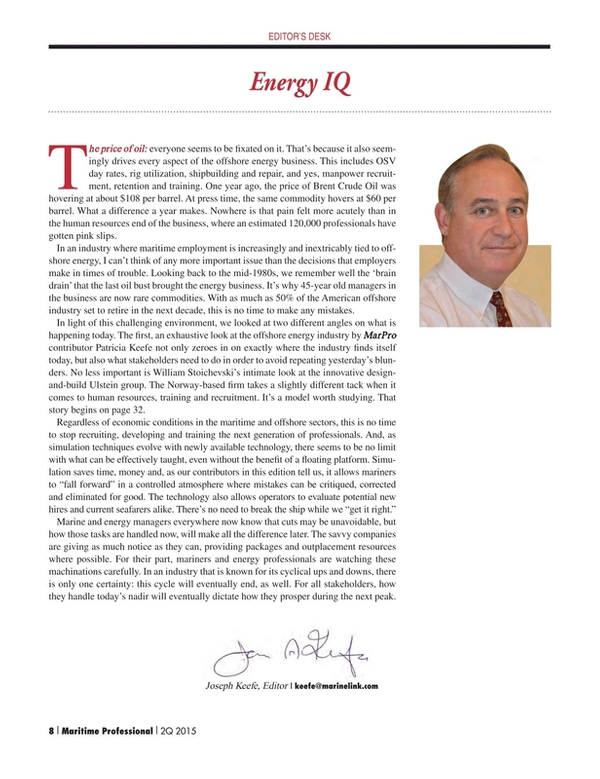
Energy IQ
The price of oil: everyone seems to be fixated on it. That’s because it also seemingly drives every aspect of the offshore energy business. This includes OSV day rates, rig utilization, shipbuilding and repair, and yes, manpower recruitment, retention and training. One year ago, the price of Brent Crude Oil was hovering at about $108 per barrel. At press time, the same commodity hovers at $60 per barrel. What a difference a year makes. Nowhere is that pain felt more acutely than in the human resources end of the business, where an estimated 120,000 professionals have gotten pink slips.
In an industry where maritime employment is increasingly and inextricably tied to offshore energy, I can’t think of any more important issue than the decisions that employers make in times of trouble. Looking back to the mid-1980s, we remember well the ‘brain drain’ that the last oil bust brought the energy business. It’s why 45-year old managers in the business are now rare commodities. With as much as 50% of the American offshore industry set to retire in the next decade, this is no time to make any mistakes.
In light of this challenging environment, we looked at two different angles on what is happening today. The first, an exhaustive look at the offshore energy industry by MarPro contributor Patricia Keefe not only zeroes in on exactly where the industry finds itself today, but also what stakeholders need to do in order to avoid repeating yesterday’s blunders. No less important is William Stoichevski’s intimate look at the innovative design-and-build Ulstein group. The Norway-based firm takes a slightly different tack when it comes to human resources, training and recruitment. It’s a model worth studying. That story begins on page 32.
Regardless of economic conditions in the maritime and offshore sectors, this is no time to stop recruiting, developing and training the next generation of professionals. And, as simulation techniques evolve with newly available technology, there seems to be no limit with what can be effectively taught, even without the benefit of a floating platform. Simulation saves time, money and, as our contributors in this edition tell us, it allows mariners to “fall forward” in a controlled atmosphere where mistakes can be critiqued, corrected and eliminated for good. The technology also allows operators to evaluate potential new hires and current seafarers alike. There’s no need to break the ship while we “get it right.”
Marine and energy managers everywhere now know that cuts may be unavoidable, but how those tasks are handled now, will make all the difference later. The savvy companies are giving as much notice as they can, providing packages and outplacement resources where possible. For their part, mariners and energy professionals are watching these machinations carefully. In an industry that is known for its cyclical ups and downs, there is only one certainty: this cycle will eventually end, as well. For all stakeholders, how they handle today’s nadir will eventually dictate how they prosper during the next peak.
(As published in the 2Q 2015 edition of Maritime Professional - www.maritimeprofessional.com)
Read Energy IQ in Pdf, Flash or Html5 edition of Q2 2015 Maritime Logistics Professional
Other stories from Q2 2015 issue
Content
- Energy IQ page: 8
- Statistics: The Perfect Storm page: 10
- The Other Side of the Flange page: 12
- So, You Want to be in Bunkers? page: 16
- Changing Classrooms for Changing Class Societies page: 20
- Weighing in With WISTA’s Leaders page: 28
- Ulstein: Stronger Than a City page: 32
- '80s Brain Drain Haunts Today’s Offshore Layoffs page: 38


